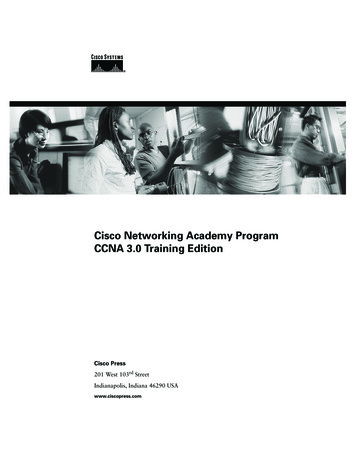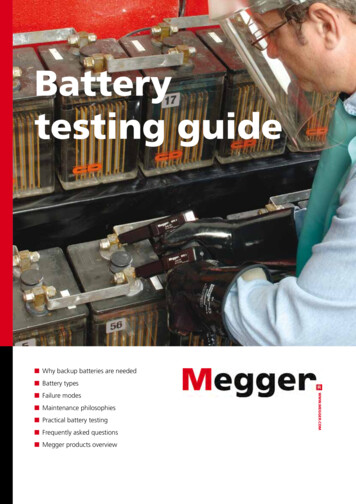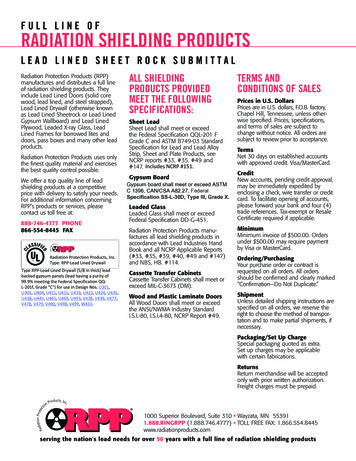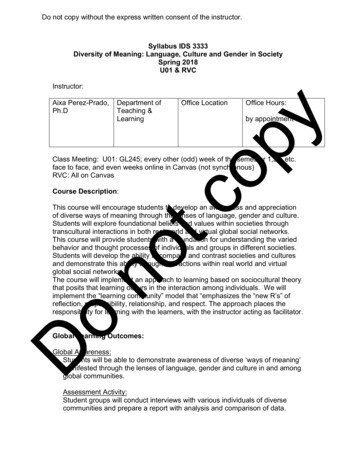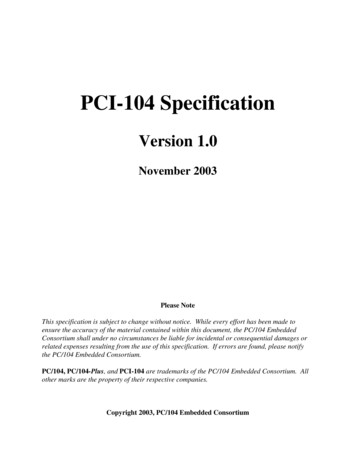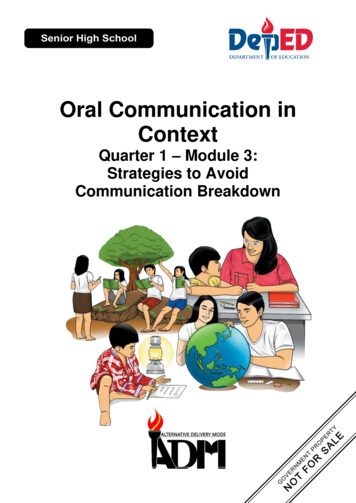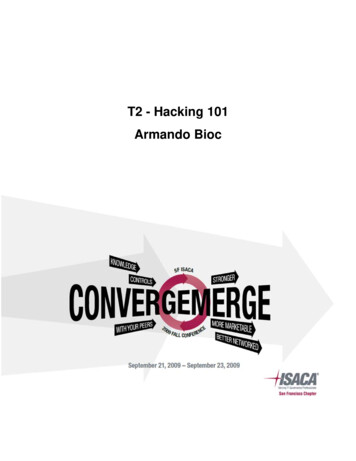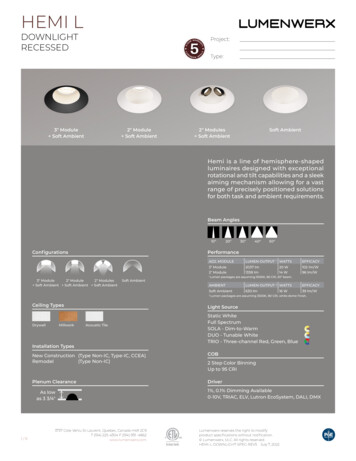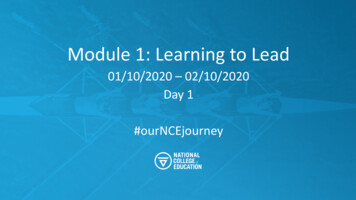
Transcription
Module 1: Learning to Lead01/10/2020 – 02/10/2020Day 1#ourNCEjourney
WelcomeNick Heard – Executive Director of the NCEVivienne Porritt - Strategic Leader of #WomenEd
Zoom Conduct: Any technical issues, contact your mentorsVideo off in main room and on in break out roomsAll participants will be mutedThe chat function can be used to share thoughts, ask questions or engage with other participantsWhere necessary, a participant may be unmuted to make a contributionChallenge! (But be kind!)We are all in this together, let’s share, learn and grow together
The National College of Education is committed todelivering the highest quality leadership and managementtraining and development within the Education sector. Our Mission is to engage, empower, and inspire a newgeneration of leaders who will transform the way thatschools are managed and led, promoting service to theircommunities and enhancing life chances for all. Our Vision is to be the home of educational leadershipdevelopment. To achieve this, we have created a platforminfrastructure of collaborative partnership networks andleadership development across all levels in schools thatsupport the delivery of world-class empirically drivenprogrammes, facilitated by exceptionally talented people. We are driven by our Values of innovation, collaboration,and excellence; to disrupt and continuously improve thesystem by unlocking millions of pounds of funding todevelop school leaders, promote diversity of thought andchallenge the meritocracy of ideas and thinking in therelentless pursuit of excellence for you.#WomenEdMission:To empower more women in educationto have the choice to progress on their leadership journeyValues:
This programme willprovide a truly diverseand informed perspectiveon leadershipdevelopment thatchallenges the inherentsystem bias that pervadesin our domain“Reducing the gender pay gap is both a moral and pragmaticnecessity, especially when the highest-paid female CEO in theFortune 500 earns 758,474,697 less than the highest-paid maleCEO. This simply cannot continue - morally, all humans have equalrights and equal value perversely, although Education is afeminized workforce, proportionately fewer women hold higherpaying senior leadership positions in schools, colleges, anduniversities: women who gain senior leadership roles are paid lessthan men. So if education systems are to set an example to othersectors, significant change is required, starting immediately.It is, for this reason, why a recent collaboration betweenWomenEd and the National College of Education is so essential,who together this week launch a flagship master’s program thatincludes mandatory content on agency, diversity, equality, equity,representation, and of course, the gender pay gap.”Source: Laker, Ben.; Porritt, Vivienne. Why Do WeNeed International Equal Pay Day? Forbes, 2020.
Academic Deadline for Essay 1:13/11/2020This module asks you to write a 4,000-word essay that critiquesthe relationship between people and high-performance. Be sureto address demonstrate the following knowledge of:1.The external environment and use of diplomacy with diversegroups of internal and external stakeholders. (K13.G.1).2.Approaches to strategic workforce planning including talentmanagement, learning organisations, workforce design,succession planning, diversity and inclusion (K11.F.3.1).3.Working with board and company structures (G14. 4.1)See knowledge criteria in Learner Handbook 6-9.
Self-Performing TeamsModule 1 Knowledge Seminar 1, Alison Robb-Webb
This session examines the componentparts required to create and sustain highperforming teams that work efficientlywith and within board and companystructures; recognising the differingdynamics needed to achieve both.
What actually isa team?
What is a team?“ a small group of people with complementaryskills who are committed to a common purpose,performance goals and approach for which theyare mutually accountable. ”Source: Katzenbach, Jon R, and Douglas K. Smith. The Wisdom of Teams: Creatingthe High-Performance Organization. Harvard Business School Press, 1993.
How do teamsdevelop?
Team development modelFormationAdjustmentEarly days; getting toknow each other;lots of saying theright thing; notrocking the boat; OKbut superficialrelationships.Source: Buck, Andy. Leadership Matters. John Catt, 2018.TrustDebateBuy-inPerformance
Team development modelFormationAdjustmentPersonal views are asserted;people vying for position;lots of assumptions aboutmotives; misunderstandingand bad feeling is notuncommon; difficult timefor the leader to manage.Source: Buck, Andy. Leadership Matters. John Catt, 2018.TrustDebateBuy-inPerformance
Team development modelFormationAdjustmentTrustTrust between teammembers is developing;they are comfortable inexposing their own worries,fears, vulnerabilities andweaknesses; they arehonest with one another;people feel valued,supported and respected byothers in the team.Source: Buck, Andy. Leadership Matters. John Catt, 2018.DebateBuy-inPerformance
Team development modelFormationAdjustmentTrustDebateTeam members trustone another enough tobe able to disagree andargue about decisionsand issues without itbeing personal; thefocus is doing the rightthing, discovering thetruth, not winning anargument.Source: Buck, Andy. Leadership Matters. John Catt, 2018.Buy-inPerformance
Team development modelFormationAdjustmentTrustDebateBuy-inThere is genuine buy-inand a strong sense ofcommitment from allteam members whenkey decisions are taken,even if there has beenearlier disagreementbecause all ideas andviews have beenproperly considered.Source: Buck, Andy. Leadership Matters. John Catt, 2018.Performance
Team development ceTeam members, not just theleader, do not hesitate to holdone another to account for theirbehaviours and adherence todecisions and standards; there isa shared sense of ownership ofthe whole team’s goals; theteam are acting as a single unitand performing highly.Source: Buck, Andy. Leadership Matters. John Catt, 2018.
Dysfunctions of a TeamInattention to resultsStatus and EgoAvoidance of accountabilityLow standardsLack of commitmentAmbiguityFear of conflictFalse harmonyAbsence of trustNeed for vulnerabilitySource: Lencioni, Patrick. Overcoming the Five Dysfunctions of a Team: A Field Guide for Leaders, Managers, and Facilitators. Jossey-Bass, 2005.
InterpersonalRelationshipsGRPI TeamEffectivenessModel ionshipsProcess &ProceduresRoles & ResponsibilitiesGoalsSource: Beckhard, Richard. (1972). Optimizing Team Building Efforts. Journal of Contemporary Business, 1972.
Because wehave to movebeyond .“polite co-operation”.
What iscollaborativeexcellence?Source: Mills, Ian.; Ridley, Mark. 100 big ideas. LID Publishing, 2013.The desire and abilitiesof parties to worktogether, each having anappreciation andacceptance of the other’sstrengths, weaknessesand differences.A willingness to share theburden of work in order tomeet each other’s needs. It iscommitment to a common goalwhilst being united in thepurpose of achieving mutualsuccess.
How do you create excellenceExcellenceExcellenceCommitment tocommon goalsExcellenceUnity ofPurposeMotivationExcellenceExcellenceStrong, HealthyRelationshipsTop QualityCommunication
Commitment to a Common GoalExcellenceHigh Actually having a clear goal or set of goals and a strategy as to how tosucceed Having agreed and known priorities Ensuring that each other’s roles are clearly understood Where all team members are productive and proactive in pursuit ofthe team goal Recognising and removing barriers that hinder performance Not being afraid to confront poor performance when functional rolesget in the way Celebrating major milestonesCommitment tocommon goals
Unity of PurposeExcellenceHigh Holding collaborative purpose-driven meetings Having robust measurement process against the end purpose Ensuring that a unified message is being advanced by the whole team Thinking “team” or “partnership” in the decision making process Not pursuing individual agendas to the detriment of the team agenda Encouraging and incorporating ideas from each team member Managing the impact of forces outside the team e.g. “rumour-mill”Unity ofPurpose
Healthy, Productive RelationshipsExcellenceHigh Having Mutual trust Having Mutual respect Having Mutual concern Respecting confidences Treating others with courtesy and dignity Encouraging others rather than being over-critical Supporting others in difficult situations Being candid, open and honest Keeping one’s wordHealthy, ProductiveRelationships Engendering a sense of belonging
Respect for Individual NeedsExcellenceHigh Appreciating different perspectives and views Seeking out others’ opinions and really listening Involving others in decision making Taking the time to explain decisions Ensuring that each person knows the value of their uniquecontribution – saying thank you Sharing confidences with others about future plans Serving others Seeking feedback about one’s own performanceRespect forIndividual Needs
Communication ExcellenceExcellenceHigh Having a planned communications strategy and sticking with it Checking to ensure that all interested parties have an opportunity tocontribute (not just those with the loudest voices!) Not assuming that since you know what you mean everyone else does Considering at all times the needs of the “Receiver”, not just you as the“Transmitter” Ensuring that critical information is disseminated in timely fashion Not allowing cynicism to prevent listeningCommunicationExcellence
What would be your line for your team?ExcellenceExcellenceCommitment tocommon goalsExcellenceUnity ofPurposeExcellenceExcellenceRespect forHealthy, productiveindividual needsrelationshipsCommunicationExcellence
Teaming “Teaming is about identifying essential collaborators andquickly getting up to speed on what they know so you canwork together to get things done.” Contrast stable teams to current challenges and the needfor more flexible teamwork Managing complicated and changing interdependencies: Curiosity Passion EmpathySource: Edmondson, Amy. Teaming: How Organizations Learn, Innovate, andCompete in the Knowledge Economy. Harvard Business Press, 2012.
Amy Edmondson’s theory ofPsychological Safety for creating andsustaining high performing teamsWhat is psychological safety:“Team psychological safety is defined as a shared belief that theteam is safe for interpersonal risk taking . [it] involves but goesbeyond interpersonal trust”Source: Edmondson, Amy. The Fearless Organisation. Wiley, 2019.
How psychological safety relates to performance standardsLow StandardsHigh StandardsHighpsychological safetyComfort ZoneLearning &High Performance ZoneLowpsychological safetyApathy ZoneAnxiety ZoneSource: Edmondson, Amy. The Fearless Organisation. Wiley, 2019.
Leading Team LearningKey determinant of team performance is a team’s ability to adapt to new ways of working, thereforethe leader must actively manage their team’s learning effortsFrame the workInvite ParticipationServe as a fallibility model Affirm the vision/guidingprinciples Be curious Destigmatise failure Build confidence thatothers’ voices are welcome Orient towards continuouslearning Set clear expectations,support and responsibilities Acknowledge gaps/uncertainty Role models desiredbehaviours for anenvironment of psychologicalsafety
Self Performing Teams Leaders at all levels have choices about the systems andprocesses supporting teams and the cultural climate in whichthey are expected to operate High performing teams within single school organisations or aspart of multi academy trusts Level of distributed leadership / central control Culture of delegation or micro-management Self managing teams Not just about looking inward and creating strong teamsbut looking at teaming across boundaries Teaming that enables the vision to evolve asproject vision may shift; the guiding principlesremain a bedrock
Looking aheadThe days of the top-down hierarchical organization are slowlycoming to an end, but changing the organization chart is only asmall part of the transition to a network of teams. The larger,more important, and more urgent part is to change how anorganization actually works.Now, more than ever, is the time to challenge traditionalorganizational structures, empower teams, hold peopleaccountable, and focus on building a culture of sharedinformation, shared vision, and shared direction.
Organisational designPercentage of respondents rating this trend ”important” or “very important”
An example Cisco, one of the world’s most successful and enduringtechnology companies, sees a team-based organizationalmodel as fundamental to its strategy. According to JohnChambers, executive chairman and former CEO, speed andtime to market are central to the company’s success: “Wecompete against market transitions, not competitors.Product transitions used to take five to seven years; nowthey take one to two.”
An example To address this continued disruption and the highlycompetitive nature of its business, Cisco has set up a newtalent organization, Leadership and Team Intelligence,focused entirely on leadership and team development,team leader selection, performance management, andintelligence-gathering for Cisco teams and their leadersaround the world.
An example Ashley Goodall, the senior vice president who runsthis group, is leading a wide-ranging redesign ofCisco’s talent practices and technologies to focus onthe optimization of team performance, team leaders,succession management, and talent mobility betweenteams. He plans to use real-time performanceconversations, ongoing pulse surveys, and textanalytics to monitor and benchmark teamperformance. The intent is to build information abouthow the best teams work together and how theydrive results, and then embed these insights into thecompany with a direct focus on employeeengagement, strengths, and empowerment.
Whereorganisationscan start,according toDeloitte Revisit your organisation’s design: Look at ways to bring functional experts into “mission-driven”teams focused on customers, markets, or products. Set up a real-time information network: A successful network brings together disparate informationon customers or products to give team members integrated data on performance in real time. Lookat how people seek and find information today using design thinking. Eliminate organisational layers: Departments whose mandate is to fix or service other parts ofthe organization should be converted to shared-service groups. Question the role and the needfor middle managers. Rethink your rewards and goals: Optimise performance management around “team performance”and “team leadership” rather than focusing solely on individual performance and designatingindividuals as leaders simply by virtue of their title or role. Reward people for project results,collaboration, and helping others. Adopt new team-based tools: Put in place tools and measurement systems that encourage peopleto move between teams,and share information and collaborate with other teams. Considerperforming an organisational network analysis. Let teams set their own goals: Teams should be held accountable for results—but let them decidehow to perform and socialise and communicate these goals among the team. Communicate shared vision and values from top leaders: Encouragesenior leaders to focus on strategy, vision, and direction, and teachthem how to empower teams to deliver results.
Now to turnknowledge intopractice
Turning Knowledge into Practice with Senior Leadership Tutors: 11:30-12:001. Reflect on the reading Edmondson (1999) Psychological Safety andLearning Behavior in Work Teams.2. Consider how you can produce greater Psychological Safety in yourleadership teams.3. Discuss what the impact would be, and why.
Lunch
WelcomeNick Heard – Executive Director of the NCEVivienne Porritt - Strategic Leader of #WomenEd
Emotional IntelligenceModule 1 Knowledge Seminar 2, Dr Adeyinka Adewale
This session explores the fundamentals ofself-awareness and emotionalintelligence, evaluating how bothconcepts impact upon ethical-driven,values-led people and performance inaccordance with the Nolan Principles.
Ground Rules All participants will be muted during this seminar The chat function can be used to share thoughts, ask questions or engage with other participants Where necessary, a participant may be unmuted to make a contribution We are all in this together, let’s share, learn and grow together
Safe Space PolicyMatters of emotion are deeply personal. All views shared must be respectedand treated as confidential information that cannot be referred to outside ofthis seminar. Use the private chat function to message me directly if you’dlike your views to be anonymised.
Initial Check In:How are you doing?How stressed are you feeling? What are your major concerns?What have been your most dominant emotions over the past few weeks?
A whole new worldWhat has Emotions got to do with it?
Opening ReflectionThe Rational Thinker ‘Myth’?Can we truly detach our emotions from work?Can we always set aside personal feelings when making professional decisions?
Everyone isperforming theirtypical roles underadditional stress,while also managingtheir own mountingwork-life challengesand staying informedabout rapidlychanging policies.Leaders’ heightenedcall to maintain theirown well-being andthat of their workers
A few thoughts Extreme stress can affect the way we act and perform School leaders experience the full gamut of emotions in their work;responding to their own and others’ emotions is a central part of the role Leaders may not feel they are free to express their real emotions For most colleagues, social support and understanding are key ingredientsto help alleviate stress and adjust work-life expectations Almost every leadership toolkit for the season has identified ‘empathy’ and‘emotional support’ as integral to weathering this storm
How do emotions fit into work?The Place of Self Awareness
AffectHow doemotions fitinto work?Emotions:Moods:Overt reactions that expressfeelings about events. They aremore intense and can influenceour judgment, memory,creativity, and reasoningUnfocused, relatively mildfeelings that exist as backgroundto our daily experiences. Theyare not usually linked to specificevents or circumstancesEmotional intelligence includes the moods and feelings wedisplay during personal interactions.Sources: Weiss & Cropanzano, 1996; Greenberg & Baron, 2003
Work Environment: Affective EventsTheoryCharacteristics of the jobJob demandsRequirements foremotional labourJob SatisfactionWork Events:Emotional Reactions: Daily hasslesDaily upliftsPositiveNegativePersonal Dispositions PersonalityMoodSource: Ashkanasy, Neil.; Dasborough, Marie. Emotion and Attribution ofIntentionality in Leader-Member Relationships. The Leadership Quarterly, 2002.Job Performance
Midway Check In:Again How are you doing?What are the ‘hassles’ and ‘uplifts’ are you currently experiencing on yourjob? How have you been responding to them?Any coping mechanisms?
Quick ScenarioParticipant 1 just left meeting where he was terribly upset by aheated exchange with one of their colleagues. They are nowexpected to walk into a high-level multi-stakeholder meetingwhich they are chairing and in which some crucial decisionswill be made. That meeting is often known to be long and attimes tense,If you were Participant 1 how will you handleyourself going into that meeting?How can leaders better stay in touch withtheir emotions?
Self-Awareness Self-awareness is the awareness of your own feelings and the ability torecognise and manage these. Self-awareness doesn't just let you see yourself better, but it also lets youbetter decipher other people and their emotions. In the earlier scenario, a leader might use their self-awareness to ask, 'how am Icoming off right now? How can I best express and deal with the emotion I amfeeling? Am I able to relate with others without transferring my aggression? Being honest about how you're actually feeling takes some vulnerability as wellas some self-awareness, but matching your behaviours to your emotions andrecognising what the effect might be on yourself and others can be a sure signthat someone has developed — and is using — their emotional intelligence.
Emotional LabourExpressing organisationally/professionally desiredemotions during interpersonal transactions on a job.E.g. handling complaints by smiling, making positiveeye contact, nodding affirmatively etc even if itmeans supressing genuinely felt emotionsSource: Hochschild, A.R. Emotion work, feeling rules, and social structure. Americanjournal of sociology, 1979.
Emotional Labour When you face angry colleagues, or people who are generallyunpleasant, emotional labour can be particularly challenging. A large part of that challenge comes from the need to hide yourreal emotions, and continue to 'smile and nod your head,' evenwhen for instance receiving negative or critical feedback. People either: express only their positive feelings, or hide ormanage their negative feelings. In dealing with –ve emotions, people show emotion they don'treally feel; Hide emotion they really do feel; Create anappropriate emotion for the situation
Emotional Labour TechniquesSurface Acting Hiding one’s true emotions Faking emotions, using smiling and softtones to mask true feelingsDeep Acting Changing one’s underlying feelings Control your emotions, rather thanpretendingSource: Hochschild, A.R. Emotion work, feeling rules, and social structure. American journal of sociology, 1979.
Reflection Questions What are the emotional labour requirements of your job? How do you deal with these requirements? How often do you experience emotional conflict?
Conceptualising EmotionalIntelligenceWhat should it look like?
Participant 2 is a wellliked manager of a smallteam. Kind andrespectful, sensitive tothe needs of others.They are a problemsolver, easy to talk to,has a strong positivemental attitude (PMA),always engaged and is asource of calm to theircolleaguesWould you agree that Participant 2is an emotionally intelligentleader?
What ifParticipant 2lacks thefollowing:Ability to deliver difficult feedback toemployees, the courage to rufflefeathers and drive change, thecreativity to think outside the box.Would that change your perceptionof their EI skills?
Self-awarenessUnderstand your own moods and emotionsSelf-AwarenessThe 4 domainsof rstand othersemotions and treatthem the way they needto be treatedSelfManagementSelf-managementControl over emotions.Thinking before actingSocial AwarenessSocial-AwarenessDevelop rapport with new peopleSource: Goleman, Daniel; Boyatzis, Richard. Emotional Intelligence Has 12 Elements.Which Do You Need to Work On? Harvard Business Review, 2017.
A commonerror Defining EI toonarrowlySociability, Sensitivity and Likeabilityalone do not make emotionallyintelligent leaders there’s more to EI
3 facts about Emotional Intelligence First, emotional intelligence does not mean that someone ispleasant all of the time. There are occasions when leaders haveto be confrontational; Second, emotional intelligence does not mean a carefreeexpression of one's feelings. Instead, emotionally intelligentleaders learn to manage feelings and express themappropriately. Third, emotional intelligence develops slowly during childhood;we learn more about it and gain the skills we need as we age.They are refined through repeated use.
Emotional Intelligence in PracticeHow do you deliver a poor performance report to astaff who is already lacking in self confidence?
PerceptionEmotions areidentifiable in oneselfand others - canexpress emotionalneedsFacilitationEmotions are used toidentify and prioritiseimportant informationSource: Mayer, John.; Salovey, Peter. Emotional development andemotional intelligence: Educational implications. Basic Books, 1997.UnderstandingRegulationApplying words toemotions andunderstanding whenemotions are blendedWorking with emotions– in oneself and others– whether positive ornot
Source: Mayer, John.; Salovey, Peter. Emotional development andemotional intelligence: Educational implications. Basic Books, 1997.
Practical Leadership ImplicationsWhat do these mean for values-based leadership?
NolanPrinciples
ReflectionHow can emotional intelligence help us deal with theexpectations of ethical decision making/ moralbehaviour in leadership?
FBI whistle blower, Colleen Rowley, who revealed the FBI’smishandling of a terrorist investigation that might have preventedthe 9/11 tragedy, has discussed the internal struggle to control herconflicting feelings of anger over the FBI’s actions, her positivefeelings for the organization that she dedicated many years to (andstill works for) and some fear for her own career, in bringing criticalinformation to the attention of FBI Director Robert Mueller.
Final Check In:What are you taking away?What are you going to start doing differently?
Now to turnknowledge intopractice
Turning Knowledge into Practice with Senior Leadership Tutors: 14:30-15:001. Reflect on the reading Heffernan (2010) Self‐compassion andemotional intelligence in nurses.2. Consider how you can produce greater levels of compassion andemotional intelligence in your leadership teams.3. Discuss what the impact would be, and why.
Break
Creating a Talent Management PlanApprenticeship Task 1
Teaching and Learning AssessmentPlan (TLAP) Log on to OneFileAccept the TLAPEnsure the Lightbulb show "0 pending"
Session OutlineA. Purpose of the Skills SeminarB.How to compose and present the answers to thequestions setC.Review of the questionsD. Where the answers can be soughtE.What the answers should containF.What to be mindful of when answering themG. Attempt a question per PLGH. Provide constructive criticism on the answer
Do you have the apprenticeshipstandards in front of you?
A. Purpose of the Skills Seminar
Talent Management:In answering your four sets of questions you are designing aTalent Management Plan. You are addressing how to:1.Recruit the talent2.Develop and retain the talent3.Deploy Talent4.Succession plan
B. How to compose and present theanswers to the questions set
B. How to compose and present the answers to the questions set Your name and your tutors name at the top of the document. Date. Each question as a heading Typed format on a Microsoft Word Document Size 12 Write precisely. Sentences longer than two/three lines are too long! Spelling and grammar check Relevant policies in the appendices (web links are also fine) Approximately 200word answers per question (half a page) Leave the other half free for tutor discussion notes
C. Review of the questions
C. Review of the questions Underline key words What are the questions asking you to do? (some might ask you ‘how are you already ’ some mightask ‘how could you better ’) Check back on the apprenticeship standards that are in brackets after your answer and make sureyour answer uses the key terms in the standards. Some may ask you to carry out tasks (e.g. the generational audit), this may mean collecting the data,but only presenting the results in the answer, analysing them and making a brief, suggestiveconclusion. Sketch a framework to answer your question using key terms or actions
Question 1.Recruit the talent1.How clear are your recruitment policies related to yourbusiness vision and strategy needs? List key reasons why thisapproach is important to organisational success (K11.F3.1)2.Have you undertaken a generational audit? What is thedemographic spread of your workforce talent? (K11.F3.1)3.How are you managing complex relationships across multipleand diverse stakeholders in relation to recruiting talent? (S201.1)
Question 2.Develop and retain the talent1.How are you enabling an open and high-performanceworking environment to support your TalentManagement strategy? Identify five key aspects of yourstrategy and three ways it could be improved (S17.1.1)2.Do these support “collective leadership”? If not, howcould they be adapted to ensure a more effectiveapproach to toward Service Leadership (S17.1.1)3.When designing effective utilisation of your workforce,how do you balance people and technical skills as wellas encouraging continual development? (S19.1.3ab)
Question 3.Deploying talent1.Managing talent can sometimes result in challengingsituations, how well are you able to manage workforceconflict? What approaches have been effective in yourrole? (S5.1.2)2.Developing talent means being able to lead and influencepeople across your organisation - how effective are you atdoing this? Identify five methods you successful use(S18.1.2)3.Deploying staff across your organisation meanscontinuous attention to team dynamics – how do youbuild constructive working relationships across teams?Do you use matrix management and if so,where has this been successful? (S18.1.2)
Question 4.Succession Planning1.What are you doing to keep engaged with the talented staffin your organisation? What else could you do to make thismore efficient? (K11.F3.1)2.How frequently do you lead beyond your mandated area ofcontrol and authority? Give an example of where you’veworked in this way and have used your negotiating andadvocacy skills to successfully build relationships. (S22.1.3)3.When are you able to influence, neg
Dysfunctions of a Team Fear of conflict Absence of trust Lack of commitment Avoidance of accountability Inattention to results Need for vulnerability Status and Ego False harmony Ambiguity Low standards Source: Lencioni, Patrick. Overcoming the Five Dysfunctions of a Team: A Field Guide for Leaders, Managers, and Facilitators. Jossey-Bass, 2005.




